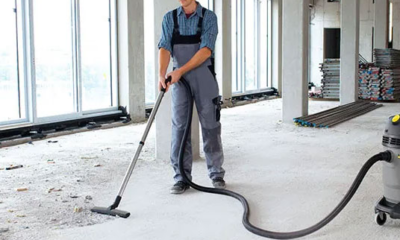Lifestyle
Eczema Creams: Striking the Balance Between Relief and Safety
Published
1 year agoon

Eczema, also known as atopic dermatitis, is a common skin condition characterized by inflamed, itchy, and often scaly patches of skin. For many individuals living with eczema, topical treatments are a primary line of defense against flares. Eczema creams, particularly those with corticosteroids like hydrocortisone, have proven effective. However, it’s crucial to approach them with care and knowledge, as misuse can lead to complications. In this article, we’ll explore why moderation is key and why low-strength hydrocortisone creams might be the better choice for long-term flares.
Understanding Eczema and Corticosteroids
Eczema is an inflammatory skin disorder. Corticosteroids, a type of steroid hormone, work by suppressing the immune response, thereby reducing inflammation and alleviating symptoms. Hydrocortisone is a mild corticosteroid commonly used in over-the-counter and prescription eczema cream.
The Dangers of Overusing Eczema Creams
While corticosteroid creams are effective, using them excessively or in high concentrations can lead to several issues:
- Skin Thinning: Prolonged use can thin the skin, making it more fragile and prone to bruises and tears.
- Topical Steroid Addiction: Over-reliance can lead to a phenomenon where the skin becomes ‘addicted.’ When the cream is discontinued, the skin might flare up more severely.
- Perioral Dermatitis: This is a pimple-like rash around the mouth and face, which can be exacerbated by steroid creams.
- Tachyphylaxis: This term refers to the reduced efficacy of the treatment when used continuously without breaks. Essentially, the more you use it, the less effective it becomes.
- Systemic Absorption: In high amounts or over large areas of the skin, there’s a risk of the corticosteroid being absorbed into the bloodstream, leading to internal side effects.
The Merits of Low-Strength Hydrocortisone for Long-Term Flares
Given the potential risks associated with stronger corticosteroid creams, a low-strength hydrocortisone cream often emerges as a safer option for managing chronic or long-term eczema flares.
Benefits include:
- Reduced Risk of Side Effects: With lower strength, the risks associated with skin thinning, addiction, and systemic absorption diminish considerably.
- Gentle for Sensitive Areas: Milder creams can be used on sensitive skin areas, like the face or the folds of the joints, with reduced risk.
- Extended Use: For those experiencing persistent flares, low-strength creams can be used for more extended periods compared to their potent counterparts, though always under medical supervision.
Using Eczema Creams Wisely
If you or someone you know is grappling with eczema, keep these points in mind:
- Consult a Dermatologist: Always start with a professional diagnosis and get recommendations tailored to the specific case of eczema.
- Follow Instructions: Use the cream as directed, both in amount and duration. More isn’t always better.
- Moisturize Regularly: Corticosteroid creams are not moisturizers. It’s essential to maintain skin hydration with a suitable moisturizer, which can also reduce the frequency of eczema flares.
- Monitor Skin Changes: Regularly check for signs of skin thinning or other changes. If you notice anything unusual, consult your dermatologist.
In Conclusion
Eczema creams, especially those containing corticosteroids, have brought relief to countless individuals. Yet, as with many medications, they should be used with respect and caution. By opting for milder treatments like low-strength hydrocortisone creams and practicing vigilant skincare, it’s entirely possible to manage eczema effectively and safely.
Recent News


Instagram Story Viewer: Shaping Social Media!
Could you think of Instagram without stories? Even though Instagram Stories were introduced not so long ago, in 2016, they...


Top Benefits of Using a Phone Appending Platform for Batch Data Updates
In the world of data-driven marketing, having access to accurate and current contact information is essential for successful customer outreach....


3 Tips for Dressing Perfectly for Special Occasions
Dressing for special occasions can sometimes be a stressful and overwhelming process, especially for women. Whether you’re attending a wedding,...


Maximise Your Hunting Success with Dive Bomb Industries Decoys
When it comes to hunting, there’s no such thing as too much preparation. Hunters understand that the right equipment can...


Castle App Free Download — Updated 2024 Version
What is Castle App? Castle App, a stream app developed for streaming media content, makes entertainment effortless by giving clients...


How to get a duplicate RC book for your vehicle: A step-by-step guide
If you have lost or damaged your vehicle’s registration certificate, you must be tense and under stress. But getting a...


Enhancing Property Value Through Professional Builders Cleaning Services in the UK
Construction and renovation projects make a ton of residue, garbage, and soil, passing on a requirement for proficient cleaning to...


Saturn in Sidereal Pisces-March 28,2024 to February 21st 2028 by Jade Luna
I really wanted a female president governing this cycle but the chart of America would choose the hardest path, not...


Top 5 Super Clone Rolex for Women
Super clone Rolex watches are incredibly detailed knock-offs of popular Rolex models, crafted to look and feel just like the...


Transforming Dreams into Reality: A Success Story of Purchase Amazon Seller Account
Purchase Amazon Seller Account: In the fast-paced world of e-commerce, many aspiring entrepreneurs dream of starting their own business. However,...
